1. Introduction
LiteOn
LTR-40125S P-CAV Recorder - Page 1
Introduction
As many other manufacturers, LiteOn used Zone-CLV to reach 40x recording speed.
Yamaha has been the only manufacturer that used P-CAV as the main recording
strategy in all models above 12x. LiteOn with a newer firmware upgrade, "changed"
from Z-CLV to P-CAV among with the adoption of Mt. Rainier format. In our first
review of LiteOn LTR-40125S, we had noticed two negative points concerning the
recording speed and the lack of Mt. Rainier. We examine how the new firmware
performs in those two categories and of course the whether the results are competitive.
Features
Using the Nero Info Tool software, we can see the drive's properties. What
has now changed in the new firmware revision (ZS0D) are:
- The buffer size (1984KB instead of 2MB as reported with previous firmware
- Mt. Rainier support

Nero 5.5.8.2 also reports the drive's new features. Mount Rainier is now supported:
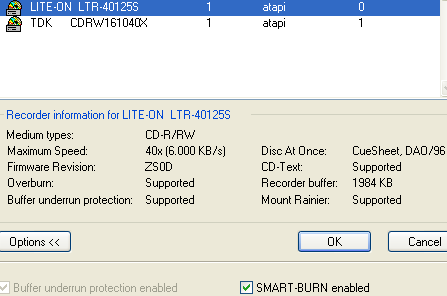
LiteOn's 40x writing speed
LiteOn LTR-40125S with the new firmware, supports the P-CAV 40x writing speed.
Below is the Nero CD Speed writing graph, which illustrates the use of P-CAV
writing technology:
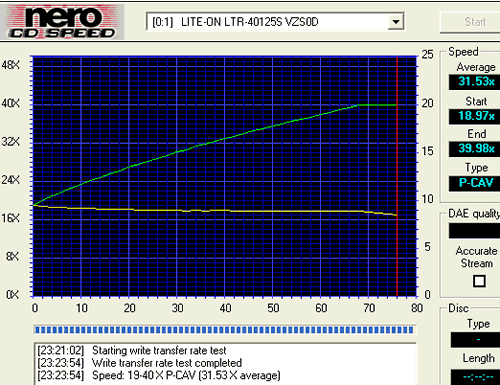
The drive starts writing at 18.97X and gradually reaches 40x (CLV) speed,
at the 68 minutes, and continues until the end in that speed. The average writing
speed is now 31.53X, instead of 30.49X with the ZS08 firmware.
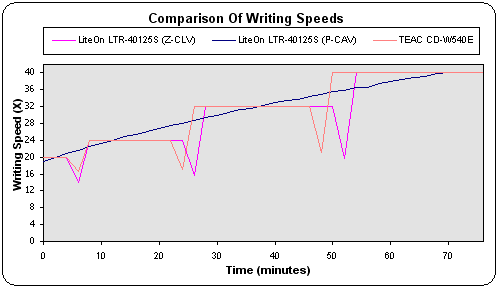
The above graph shows the writing speeds of LiteOn LTR-40125S with ZS08 (Z-CLV),
with ZS0D (P-CAV) and are compared with the faster 40x recorder from TEAC CD-W540E.
Despite the fact that TEAC CD-W540E reaches 40x speed at around 50 minutes,
the LiteOn LTR-40125S with P-CAV writing technology is faster.
|
Drive
|
Average Writing Speed (X) with 80min
CDs
|
|
PleXWriter PX-W4012A
|
29.91
|
|
ASUS CRW-4012A
|
30.39
|
|
LIteOn LTR-40125S (Z-CLV)
|
30.49
|
|
TEAC CD-W540E
|
31.25
|
|
LiteOn LTR-40125S (P-CAV)
|
31.53
|
The above table gives the average writing speed of various 40x recorders.
The LiteOn LTR-4125S with the use of P-CAV is faster without any doubt.

The LiteOn drive continues to keep its rotation speeds high enough, above
9000rpm. The drive is noisy but the operation is smoother due to the lack of
increased rotation speed shifts (as happens with Z-CLV recorders).
2. Writing speed tests
LiteOn
LTR-40125S P-CAV Recorder - Page 2
Writing speed results
74min CDs
|
74min CD - 32x Writing Speed
|
|
Drive
|
Burning Time (sec)
|
|
LiteOn LTR-40125S (Z-CLV)
|
193
|
|
TEAC CD-W540E
|
194
|
|
LiteOn LTR-40125S (P-CAV)
|
187
|
The LiteOn drive at 32x speed is faster by 6secs from the Z-CLV implementation.
It needs only 3minutes and 7 seconds to end the task.

|
74min CD - 40x Writing Speed
|
|
Drive
|
Burning Time (sec)
|
|
LiteOn LTR-40125S (Z-CLV)
|
188
|
|
TEAC CD-W540E
|
184
|
|
LiteOn LTR-40125S (P-CAV)
|
179
|
At the maximum speed, LiteOn's P-CAV is 9secs faster than the LiteOn Z-CLV
model, but only 5 seconds faster than the TEAC CD-W540E.

80min CDs
|
80min CD - 32x Writing Speed
|
|
Drive
|
Burning Time (sec)
|
|
LiteOn LTR-40125S (Z-CLV)
|
203
|
|
TEAC CD-W540E
|
206
|
|
LiteOn LTR-40125S (P-CAV)
|
197
|
With 80min CDs the LiteOn LTR-40125S with P-CAV is again 6seconds faster than
the Z-CLV implementations.

|
80min CD - 40x Writing Speed
|
|
Drive
|
Burning Time (sec)
|
|
LiteOn LTR-40125S (Z-CLV)
|
195
|
|
TEAC CD-W540E
|
193
|
|
LiteOn LTR-40125S (P-CAV)
|
187
|
At the maximum writing speed, the LiteOn (P-CAV) is 6secs faster than TEAC
CD-W540E and 8secs faster than the LiteOn (Z-CLV).

3. Writing Quality tests
LiteOn
LTR-40125S P-CAV Recorder - Page 3
Writing Quality
We used Mitsui 80min 32x & 40x certified media burned many CDs at 32x
and 40x recording speeds with LiteOn LTR-40125S. We used Nero 5.5.8.2 as a CDR
software. The produced CDs were measured by DigitalDrives
and the results are illustrated in the following tables:
32x writing speed
|
Brand
|
C1
|
Average Burning Time (mins)
|
|
Max
|
Average
|
|
Mitsui 74min 32x (SmartBurn On)
|
82
|
2.3
|
3:07
|
|
Mitsui 80min 32x (SmartBurn On)
|
21
|
0.4
|
3:17
|
As it seems with 74min CDs, LiteOn LTR-40125S has some problems to keep the
writing quality high in the first 10 minutes. The drive makes a high peak at
around 5mins, which is worrying. The writing quality in the rest of the disc
seems very good. This problem was not noticed when writing 80min CDs, and the
average C1 error rate is low (0.4). Below is the C1 error rate graph when writing
74min CDs:
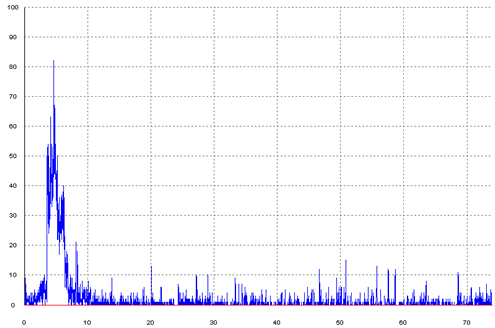
40x writing speed
|
Brand
|
C1
|
C2
|
Average Burning Time (mins)
|
|
Max
|
Average
|
Max
|
Average
|
|
Mitsui 74min 32x (SmartBurn On)
|
379
|
4.2
|
0
|
3:00
|
|
Mitsui 74min 16x (SmartBurn On)
|
25
|
3.1
|
2:59
|
|
Taiyo Yuden 74min 24x (SmartBurn On)
|
8
|
0.2
|
2:59
|
|
Taiyo Yuden 74min 24x (SmartBurn Off)
|
13
|
0.2
|
2:59
|
|
Ricoh 74min 24x (SmartBurn On)
|
28
|
1.6
|
3:00
|
|
Mitsui 80min 32x (SmartBurn On)
|
22
|
0.7
|
3:09
|
|
Mitsui 80min 32x (SmartBurn Off)
|
19
|
0.6
|
3:07
|
|
Imation 80min 32x (SmartBurn On)
|
137
|
4.4
|
161
|
0.3
|
3:09
|
When writing at Mitsui 74min CDs the drive again has problems and produces
high C1 error rate in the first 10 minutes. With other media, even with Mitsui
16x the error rate is lower. Especially with Taiyo Yuden media, the C1 average
error rate is 0.2. The picture below comes from Mitsui 74min 32x certified:
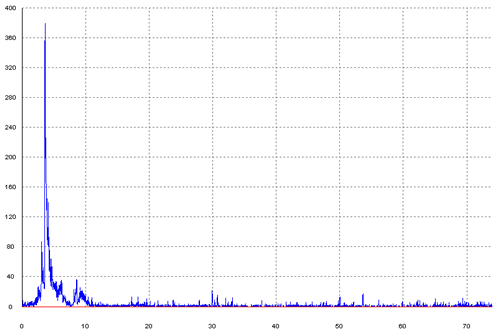
With Imation 80min 32x CDs, the drive produced C2 (un-correctable) errors in
the end of the disc:
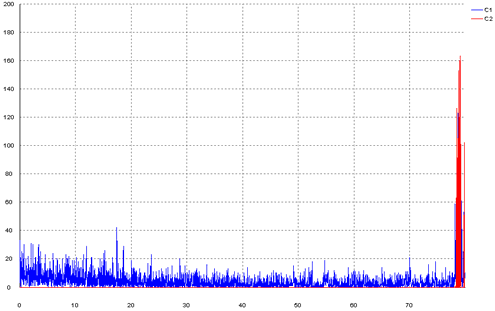
4. AudioCD Authoring
LiteOn
LTR-40125S P-CAV Recorder - Page 4
Authoring AudioCD at 40x P-CAV
LiteOn permits the authoring of AudioCDs at 40x writing speed. Despite that
fact that P-CAV doesn't have any fast speed shift points, the produced writing
quality does seem to have problems, especially in the beginning. If we see the
error rate in the duration of the disc, we can see a high C1 error rate at the
first few minutes (2-8). There is a high peak of an 150 C1 error rate that rises
the average error rate up to 3.9.
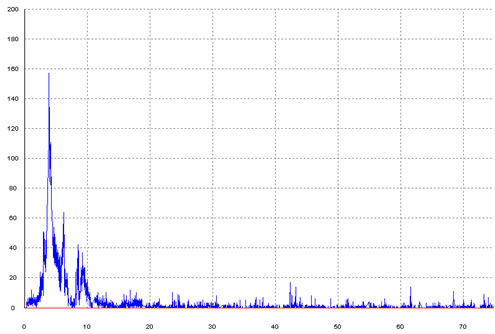
The produced CD also causes problems to the same drive, when trying to read
it, as CD Speed shows:

5. Mt. Rainier tests
LiteOn
LTR-40125S P-CAV Recorder - Page 5
Mt. Rainier support
With the new firmware update, the drive also supports Mt. Rainier format. For
these tests, we used WriteCDRW!
PRO by Software Architects and Ahead InCD. After installing latest InCD
v3.28, the following screen comes up when inserting a blank HS-RW media:

After formatting the disc which takes less than 2 minutes, InCD prompts us
that the disc is ready for use:
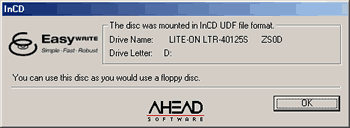
Lets check the drive's properties. Mount Rainier option is there:

If we leave the disc inside the drive for around 15minutes the disc background
format will be completed:
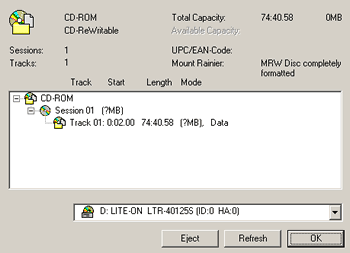
If we make an early eject, then our disc will be partially formatted :
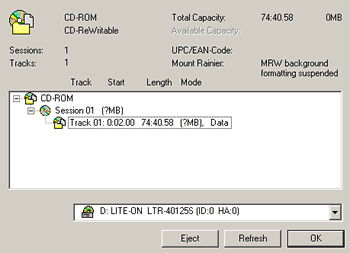
In order to test the Mt Rainier capabilities of the drive with WriteCDRW!
software, we had to uninstall the InCD first. After we installed the WriteCDRW!
PRO v3.0.4 and rebooted, we were ready to proceed to the HS-RW format. The
following window came up:

Recording Tests
For testing the Mt. Rainier performance of the drive we performed two tests.
First Test
After the format process, we immediately start the recording process (drag
& drop). When the drive finishes, we start the reading process back to the
HD. At this mode, the drive writes, reads the quality of the written data and
background formats the disc at the same time. The recording performance of each
drive is displayed in the below table:
|
Drive
|
Average Writing Speed (X)
|
Average Reading Speed (X)
|
|
TEAC CD-W540E
(v1.0b firmware)
|
3.45
|
3.77
|
|
Mitsumi CR-480ATE
(v1.0E firmware)
|
2.38
|
5.40
|
|
Yamaha CRW3200E
(v1.0d firmware)
|
2.55
|
-
|
|
LiteOn LTR-40125S
(vZS0D)
|
8.40
(InCD)
|
8.60
(InCD)
|
|
LiteOn LTR-40125S
(vZS0D)
|
1.3
(WriteCDRW!)
|
19.8
(WriteCDRW!)
|
The InCD results seems to be strangely high. We believe that
the results we had with the WriteCDRW! software are more reasonable and the
InCD v3.28 possibly supports a different formatting process in order to give
these results. LiteOn LTR-40125S was a slow writer but a very fast reader under
Mt Rainier format.
Second Test
At the second test, we left the drive alone to complete the background formatting
and afterwards, we repeated the above tests. The recording/reading performance
in this case is higher for all the drives, since now only record & read
are performed. The disc has been scanned for bad sectors during the format process:
|
Drive
|
Average Writing Speed (X)
|
Average Reading Speed (X)
|
|
TEAC CD-W540E
(v1.0b firmware)
|
2.65
|
7.03
|
|
Mitsumi CR-480ATE
(v1.0E firmware)
|
3.34
|
8.76
|
|
Yamaha CRW3200E
(v1.0d firmware)
|
3.89
|
18.32
|
|
LiteOn LTR-40125S
(vZS0D)
|
8.40
(InCD)
|
19.44
(InCD)
|
|
LiteOn LTR-40125S
(vZS0D)
|
5.5
(WriteCDRW!)
|
19.8
(WriteCDRW!)
|
In the InCD test, the LiteOn LTR-40125S has the same speed as
before. The reading speed has been increased dramatically up to 19.44X which
is the fastest compared to other drives. The WriteCDRW! showed a lower performance
than InCD but the drive is still faster than the competition. The disc was checked
and all files were readable. In the reading part, LiteOn LTR-40125S is the fastest
among the other drives.
6. Conclusion
LiteOn
LTR-40125S P-CAV Recorder - Page 6
Conclusion
For sure it was a very good surprise to see a company to change the writing
technology for a CD-RW drive with a simple firmware update. The LiteOn LTR-40125S
was one of the faster 40x recorders, and now with the new P-CAV writing technology
it becomes the faster recorder in all speeds. There were some glitches at the
writing quality but hopefully the final firmware will have its problems fixed.
LiteOn already ships its new drives with P-CAV implemented (LTR-30125W and LTR-40125W).
The other requested feature, Mt. Rainier is present and seems to work. Of course,
the support level of this format is still in an early stage for all the drives.
Several other manufacturers plan to use P-CAV for their high-speed recorders.
Sony with CRX195 and LG with the GCE-8400B will ship two more 40x P-CAV recorders,
while Yamaha is around the corner with a new P-CAV recorder that promises to
break the time limits. As for other manufacturers, we would like to see more
P-CAV implementations in the near future...